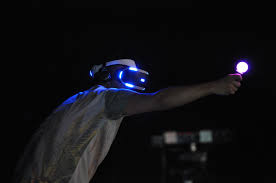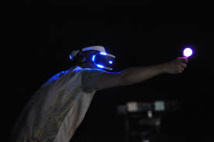Designed as an accessory for Sony consoles, ambitious PlayStation VR is a virtual reality helmet, which can be connected to any version of PlayStation 4. According to Shuhei Yoshida (President of SCE Worldwide Studios), the gadget has been created to change future of video games.
230 developers (independent teams and large studios) will support the new technology, creating games specifically for the unique needs. The first portion (includes Batman: Arkham VR and Until Dawn: Rush of Blood) has hit store shelves along with the helmet itself. In the future, many blockbusters like Resident Evil 7 can played-through entirely by means of PS VR.
Features of PlayStation VR (in addition to surround sound and high quality images) include an opportunity to take a game together with friends. Thus, Sony wants to make a joint virtual reality entertainment.
Sony derives a considerable share of profits from the entertainment areas, with games projects prevailing. In the near future, projects for PlayStation VR will become a new source of income. However, mobile virtual reality, gradually gaining momentum, does not look interesting to Sony. According to a source, Executive Director of Sony Interactive Entertainment Andrew House said that smartphones are not yet able to provide a full experience of immersion in a different reality.
According to him, the company is focused on high-grade feelings that PSVR can give, and smartphones cannot keep up with the technology. At least, all this is true for the gaming areas. At the same time, Sony understands potential of virtual reality in other segments, and therefore intends to actively work with non-gaming content.
Aggressive promo campaigns of smartphones vendors and entry of new VR solutions for mobile gadgets like Google Daydream View, will rise presence of VR devices around the world from 4 million in 2015 to 81 million in 2020.
During the same period, spending of users will reach $ 7.9 billion. Additional $ 3.3 billion will go to VR games and other entertainments, IHS analysts predict.
As explained by Piers Harding-Rolls, director of IHS analysts gaming market, presence of VR devices will grow mainly on budget devices. Yet, manufacturers of expensive models will get their share from content monetization. Thus, the market of equipment for virtual reality will be strongly polarized.
In 2016, users are expected to spend $ 1.6 billion on virtual reality helmets as the market will be stirred by high-end solutions from Oculus, HTC and Sony. Appearance of these products will rise an average price of VR-devices from $ 26 in 2015 to $ 85. Another jump to 191 dollars is expected in 2017.
The market of VR content and services is estimated separately. Its volume will increase tenfold from $ 310 million in 2016 to $ 3.3 billion in 2020.
IHS predicts that sales of Sony PlayStation VR will surpass in terms of sales Oculus Rift and HTC Vive together. In 2016, they will amount to 1.4 million units (and will generate $ 134 million of indirect profits from entertainment services).
source: theverge.com, usatoday.com
230 developers (independent teams and large studios) will support the new technology, creating games specifically for the unique needs. The first portion (includes Batman: Arkham VR and Until Dawn: Rush of Blood) has hit store shelves along with the helmet itself. In the future, many blockbusters like Resident Evil 7 can played-through entirely by means of PS VR.
Features of PlayStation VR (in addition to surround sound and high quality images) include an opportunity to take a game together with friends. Thus, Sony wants to make a joint virtual reality entertainment.
Sony derives a considerable share of profits from the entertainment areas, with games projects prevailing. In the near future, projects for PlayStation VR will become a new source of income. However, mobile virtual reality, gradually gaining momentum, does not look interesting to Sony. According to a source, Executive Director of Sony Interactive Entertainment Andrew House said that smartphones are not yet able to provide a full experience of immersion in a different reality.
According to him, the company is focused on high-grade feelings that PSVR can give, and smartphones cannot keep up with the technology. At least, all this is true for the gaming areas. At the same time, Sony understands potential of virtual reality in other segments, and therefore intends to actively work with non-gaming content.
Aggressive promo campaigns of smartphones vendors and entry of new VR solutions for mobile gadgets like Google Daydream View, will rise presence of VR devices around the world from 4 million in 2015 to 81 million in 2020.
During the same period, spending of users will reach $ 7.9 billion. Additional $ 3.3 billion will go to VR games and other entertainments, IHS analysts predict.
As explained by Piers Harding-Rolls, director of IHS analysts gaming market, presence of VR devices will grow mainly on budget devices. Yet, manufacturers of expensive models will get their share from content monetization. Thus, the market of equipment for virtual reality will be strongly polarized.
In 2016, users are expected to spend $ 1.6 billion on virtual reality helmets as the market will be stirred by high-end solutions from Oculus, HTC and Sony. Appearance of these products will rise an average price of VR-devices from $ 26 in 2015 to $ 85. Another jump to 191 dollars is expected in 2017.
The market of VR content and services is estimated separately. Its volume will increase tenfold from $ 310 million in 2016 to $ 3.3 billion in 2020.
IHS predicts that sales of Sony PlayStation VR will surpass in terms of sales Oculus Rift and HTC Vive together. In 2016, they will amount to 1.4 million units (and will generate $ 134 million of indirect profits from entertainment services).
source: theverge.com, usatoday.com



















